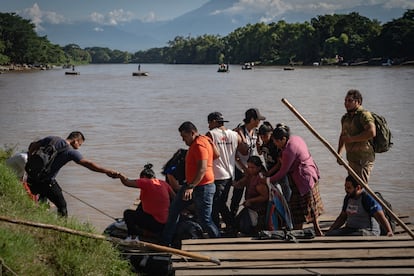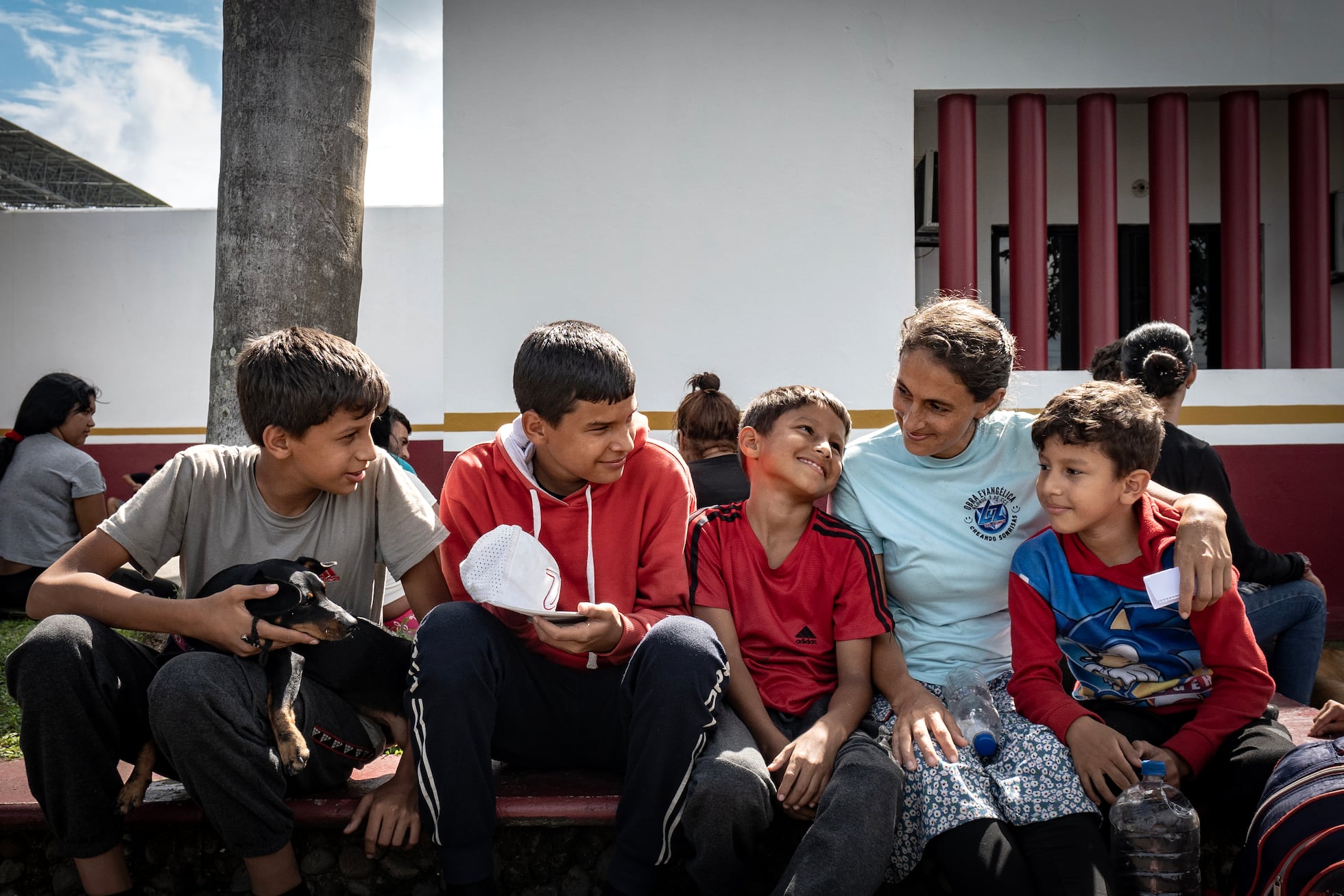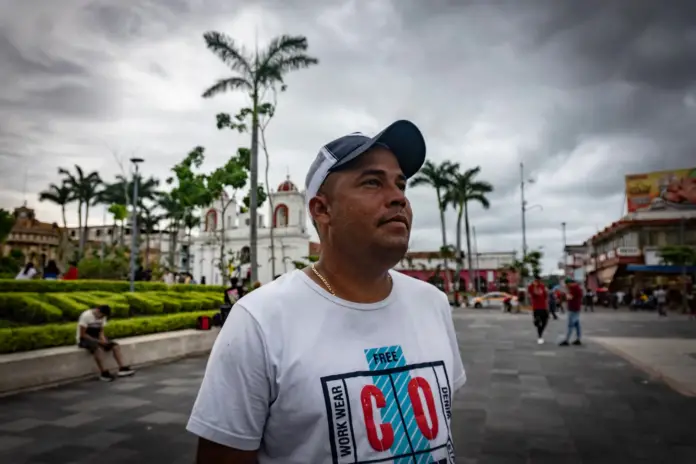
Yessica left Venezuela a year ago, pregnant, to seek a better future far from the economic and political crisis in her country. The destination: the United States, 5,000 kilometers away. The little money she saved, the fatigue of walking with swollen feet from pregnancy, and the dangers of the road turned her and her family’s journey into an obstacle course. Yessica is traveling with her three children, her husband, her brother, and her mother. “We have been to Colombia, Panama, Costa Rica, Nicaragua, Honduras, Guatemala, and now Mexico,” says the 34-year-old woman, from a shelter in Tapachula, in the border state of Chiapas. The baby was born during the summer rains, in the middle of the Guatemalan jungle. “It was very hard,” she says. “Although the hardest part has been crossing Mexico,” she adds. “They kidnapped us when we crossed the river, they put us in a house, and we had to pay $100 each to let us go.” In total, they had to pay the cartel $800 to escape. Now, they continue to wait for the US authorities to give them an appointment to request asylum in that country. The CBP One application of Customs and Borders has allowed since this summer to do the paperwork from the southern border of Mexico and wait there until they are called.
This fact, added to the crises due to violence in several countries, has doubled the irregular entries, especially of migrants from Venezuela, Ecuador, Honduras and Guatemala. The data already exceeds 828,000 people so far in 2024, according to official data. More than what was recorded by the authorities during all of 2023. They are fleeing violence, poverty and the effects of climate change. Of all of them, about 97,000 are children. The images of massive caravans with thousands of people have given way to smaller groups, but the trickle of people is constant on this porous border. The authorities, the smugglers, the drug dealers, the boatmen who cross the Suchiate River and the local population know it. “People have a lot of hope in this application, the number of people has increased by more than 100%,” says priest César Cañaveral, administrator of the Belén migrant shelter in Tapachula.
Javier, a 37-year-old Venezuelan, works temporarily in the Miguel Hidalgo Central Park, in Tapachula.
Javier, a 37-year-old Venezuelan, works temporarily in the Miguel Hidalgo Central Park, in Tapachula.
Nayeli Cruz
The feeling of most people in transit is similar. “We do it to have a better life,” says Javier, a 37-year-old Venezuelan, who shows the CBP One application on his cell phone. “And we do it for our children,” a countryman interrupts him. Javier arrived in Tapachula 15 days ago. Before that, he had been working for five years in Chile, but the authorities of that country ruled his expulsion. In Tapachula’s Central Park, next to the church, he meets with other countrymen to work. The mosaic of faces and accents makes it clear that the city has become one of the nerve centers of migration in Mexico. In the mornings, Javier sells coffee at affordable prices and, in the afternoons, he offers chips for cell phones and money transfers from nearby stores. With this he earns a small commission. “Yesterday I made 150 pesos [about 7 dollars], but life is very expensive; everything here costs,” he says.
Tapachula has become a reflection of what happens in other parts of Chiapas. The territorial dispute between criminal groups has reached the border city. Murders, extortions and kidnappings are the order of the day. On October 1, six migrants traveling in the back of a truck, not far from the city, were killed by the Army at a roadblock between Huixtla and Villa Comaltitlán. They and the survivors, some from Egypt, El Salvador and Peru, wore a stamp on their arms to be identified. Human trafficking is a business as profitable as drug and arms trafficking. On Monday, the bodies of two other migrants from El Salvador were found in a sugarcane field. They had been shot in the head. Meanwhile, organizations and churches have demonstrated against the violence. More than 3,000 evangelicals gathered two weeks ago in the center of Tapachula to pray and demand a ceasefire. For its part, the diocese has directly accused the Army of having ties to drug trafficking and being involved in kidnapping and extortion crimes. “Migrants are the poorest of the poor and as a Church we cannot allow this type of abuse and death,” says César Cañaveral.
Three boys have just gotten off a raft on the banks of the Suchiate River, the natural border between Mexico and Guatemala. The fear on their faces and the nervousness make them walk quickly. They are 25, 27 and 30 years old. They only answer that they are from Venezuela and that they fled due to the crisis in their country after the elections. As they disembark, several men
Three young men have just gotten off a raft on the banks of the Suchiate River, the natural border between Mexico and Guatemala. The fear on their faces and the nervousness make them walk quickly. They are 25, 27 and 30 years old. They only respond that they are from Venezuela and that they fled because of the crisis in their country after the elections. As they disembark, several men on a motorcycle approach the migrants and try to escort them. This is usually the step prior to kidnapping. Afterwards, they will take them to a remote place and force them to get on a transport; others may be locked up directly, as happened to Yessica and her family.
The authorities, in response to the violence of these weeks, have installed more operations at the exits of the city and the roads that connect with the border municipalities. The Army, the National Guard, the State Attorney General’s Office and the municipal police stop vehicles randomly and check their occupants. Between vast fields of green bananas, on the highway leading to the border town of Ciudad Hidalgo, a National Guard checkpoint watches over cars that slow down. Next to it is a checkpoint of the National Institute of Migration (INM). The agents have just stopped a group that was walking along the side of the road and load them into a van. The people are taken to the Siglo XXI migrant detention station, some 40 kilometers north of there. The INM tried to change its image after the tragic death of 40 men at an immigration station in Ciudad Juárez, Chihuahua. However, despite the attempt to makeover it, the place still looks like what it is: the largest migrant detention center in the country.
Yolimar, 36, has just left the detention center. She has a sad look and a tired body. Despite everything, she jokes with her children and tries to cheer them up. “I thought they were going to have a worse time, but they see all this as an adventure and I try not to let it affect them,” she says while hugging them. She, the four children and her dog Serenata left Caracas a month ago. Their destination: Chicago, where her husband lives. To get to Tapachula, the family crossed the hell of Darien on foot. A thick jungle between Colombia and Panama from which many do not come out alive. “We saw several dead people. A mother and her daughter died inside a tent and we couldn’t do anything for them. Then, the police in Costa Rica stole 300 dollars from us and now we have run out of money to continue,” she says with sad eyes. When she arrived in Mexico, she decided to turn herself in to Immigration. The INM gave her a permit to move around Chiapas until her humanitarian visa application is resolved. However, her idea is to continue north. If she left Chiapas, she could be detained again or even deported to Venezuela.

The shelters in Tapachula are full and most exceed their capacity, such as the Belén shelter. With a maximum of 150 places, it currently has 270 people housed and more are waiting at the door to be attended to. “Migrants have not stopped arriving, but with the application more people began to enter,” says Father Cañaveral.
Despite the high concentration of migrants, the region does not have sufficient infrastructure to care for people in transit. Many of them sleep and survive on the streets, as best they can. Most of these people arrive with the hope of continuing north, although more and more are choosing to stay and live in Mexico and seek refugee status in the country. The Mexican Commission for Refugee Assistance (Comar) issued nearly 129,000 humanitarian visas in 2023, mainly to citizens of Haiti, Honduras, Cuba and Guatemala. “We have noticed that this year the number of applications is on the rise; we currently serve 400 people a day,” says César Eloa, head of the Comar Registration Area in Tapachula.
The implementation of CBP One from the southern border has allowed the concentration of migrants to be reduced in border cities such as Juárez, Tijuana or Piedras Negras, however, that does not save them from the risks involved in the journey. The uncertainty is total. Once the date of the appointment is assigned, they must present themselves at the indicated border post by their own means. The procedure continues to be confusing for many and misinformation is rampant. “The authorities try to tire them out and disorient them so that they give up, but they will continue forward, even if it costs them their lives,” says the director of the Belén shelter.
Source: elpais






